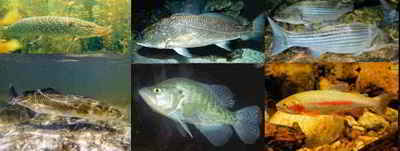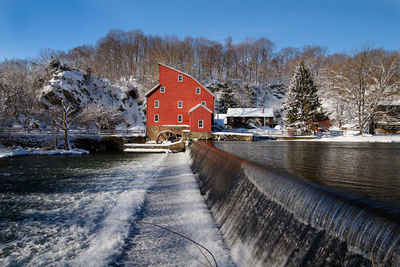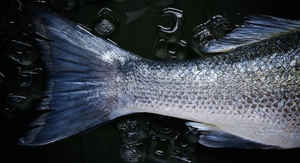New Jersey State Fish
Brook Trout

(Salvelinus fontinalis)
Adopted on January 8, 1992.
The brook trout, (Salvelinus fontinalis,) is New Jersey's official fish, having been so declared by Chapter 342 of the Laws of 1991. The Legislature passed Assembly Bill 2608 and Governor James J. Florio signed it January 8, 1992 at Hopatcong Middle School, Hopatcong.
The brook trout, which joined the other State symbols in 1992. This native New Jersey fish received its name from the Pilgrims. The brook trout is very sensitive to pollution and other changes in the environment. Therefore, its presence assures good water quality.
The Brook Trout takes first place for the most popular state fish with these states claiming it for their Official State Fish; Maine, Michigan, New Hampshire, New Jersey, New York, Pennsylvania, Vermont, Virginia, and West Virginia. Taken as a whole, trout dominate the Official State Fish category with 18 states calling some type of trout their Official State Fish.
New Jersey State Fish: Brook Trout

The Brook Trout, (a.k.a. - Speckled Trout) are also called brook char and belong to the char group. They have been termed the white rat of aquatic science because more experimental work has been done on this species than any other. Since they live naturally under cool water conditions that are clean, pure, and aesthetically appealing, much of the knowledge gained from these studies help form a basis for understanding the requirements of all salmonids.
Considered an Ice Age relict, this member of the char family is found only in cold water streams of the mountains. Often a brilliantly colored fish, it is readily identifiable by the white leading edge, backed by black, on its lower fins.
Characteristics of the Brook Trout
The average length is 10-12 inches but Brook Trout can be caught measuring up to 21 inches and weighing 4-6 pounds. The largest Brook trout on record was 14.5 pounds and caught in 1916 in the Nipigon River in Ontario. Breeding males develop a hook at the front of the lower jaw. Typical coloring is olive-green to dark brown on the back with silvery sides and pale spotting. All colors intensify at spawning time.
Distribution
The brook trout is native to northern North America and is widely distributed throughout the maritime provinces. It occurs in clear, cool, well-oxygenated streams and lakes.
Foods
Brook trout are opportunistic feeders and will eat whatever they can find. In small streams they prefer aquatic insects (nymphs) that live under the rocks and along the stream bottom. They are also known to feed heavily on the adult stage of aquatic insects as they hatch and take flight during their brief courtship and egg laying cycle. Land insects, like ants and beetles, that fall into the water are readily eaten as are small crayfish. They will eat other small fish and minnows but only when they are easy to catch.
Biology
This species spawns in late summer or autumn in gravel beds in the shallows of headwaters of streams. The female digs the redd where she lays 100-5000
eggs depending on her size. They hatch 50-100 days later. The life expectancy is an average of five years. The brook trout is carnivorous and feed
upon a wide range of organisms. They have been known to eat their own eggs at spawning time and even their own young.
New Jersey ASSEMBLY, No. 2608
ASSEMBLY, No. 2608
STATE OF NEW JERSEY
Pre-filed for Introduction in the 1990 Session
By Assemblymen SCHLUTER and KAMIN
AN ACT designating the brook trout as the New Jersey State Fish.
WHEREAS, The brook trout received its name from the Pilgrims and has delighted outdoorsmen since colonial days with its vibrant colors and fighting
form; and
WHEREAS, This fine species of fish inspired the Reverend Myron Reed, a noted angler of his day, to praise it as "...the gold sprinkled living arrow
of the white water; able to zig-zag up the cataract; able to loiter in the rapids; whose dainty meat is the glancing butter fly"; and
WHEREAS, Naturally occurring populations of brook trout are found in the northwest part of the State and in the Pinelands; and
WHEREAS, Over 200,000 brook trout are raised each year at the Pequest Trout Hatchery as part of the State's trout stocking program; and
WHEREAS, The brook trout is highly sensitive to changes in its natural habitat and is therefore, a good indicator of environmental quality; and
WHEREAS, Because of a reduction in the number of brook trout in the wild due to destruction of its habitat by human development, the State has designated
the brook trout a threatened species; and
WHEREAS, Public support for protecting the brook trout's habitat would contribute to the preservation of New Jersey's wilderness areas, it is fitting
that the brook trout be accorded special recognition.
BE IT ENACTED by the Senate and General Assembly of the State of New Jersey:
1. The brook trout (Salvelinus fontinalis) is designated as the New Jersey State Fish.
2. This act shall take effect immediately.
STATEMENT
This bill designates the brook trout as the New Jersey State Fish. Naturally occurring populations of brook trout are found in several parts of the
State and annually thousands of hatchery-raised brook trout are placed in streams and rivers throughout the State as part of the State's stocking program.
This species of fish deserves special recognition because of the pleasure it continues to bring to sport fishermen and because promoting public support
for protecting the habitat of the brook trout, which is highly sensitive to environmental changes, will serve to preserve and protect the State's wilderness
areas.
STATE GOVERNMENT
Designates the brook trout as the State fish.
New Jersey Law
The law designating the brook trout as the official New Jersey state fish is Section 52:9A-6 (Designation of State Fish) of the New Jersey Statutes, Title 52 (STATE GOVERNMENT, DEPARTMENTS AND OFFICERS) Section 52:9A-6.
The following information was excerpted from the New Jersey Revised Statutes, Title 52, Section 52:9A-6.
TITLE 52 - STATE GOVERNMENT, DEPARTMENTS AND OFFICERS.
SECTION 52:9A-6.
52:9A-6. Designation of State Fish.
1. The brook trout (Salvelinus fontinalis) is designated as the New Jersey State Fish.
L.1991,c.342
Taxonomic Hierarchy: Eastern Brook Trout
Kingdom: Animalia - animals
Phylum: Chordata - chordates
Subphylum: Vertebrata
Superclass: Osteichthyes - bony fishes
Class: Actinopterygii - ray-finned and spiny rayed fishes
Order: Salmoniformes - salmon and trout
Family: Salmonidae - salmon and trout
Genus: Salvelinus --
Species: Salvelinus fontinalis








